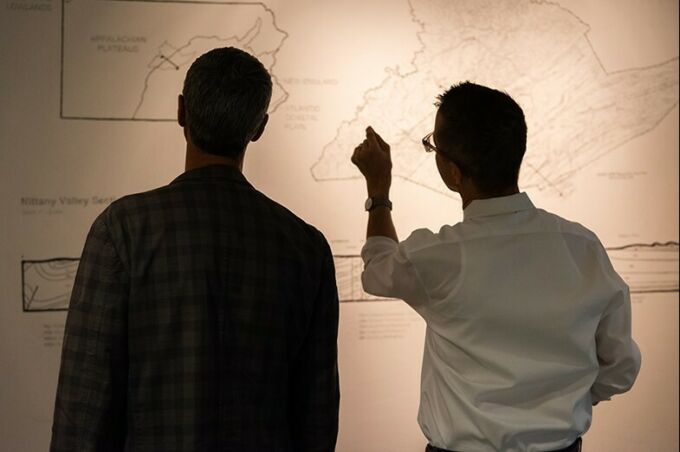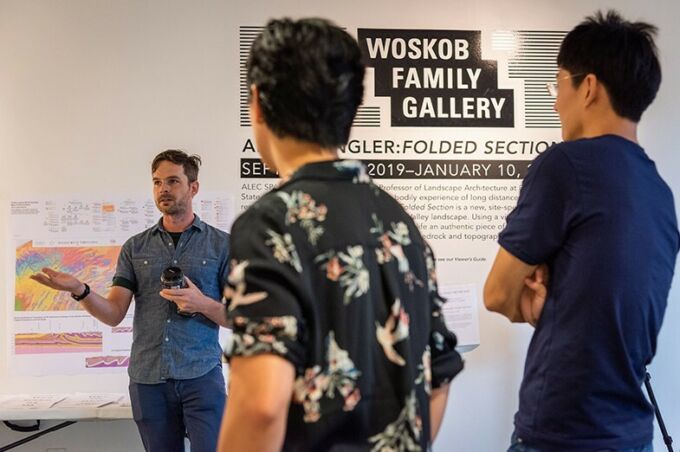September 25, 2019
Stuckeman School professor's two passions on display in Woskob Family Gallery

STATE COLLEGE, Pa. – The large charcoal and graphite drawing on display at the Woskob Family Gallery is an artistic re-envision of the Central Pennsylvania landscape, blending the two passions of Alec Spangler into one exhibit – art and the study of an area’s landscape. Spangler is an assistant professor of landscape architecture at Penn State.
“Folded Section,” which opened on Sept. 6 and runs through early January 2020, tries to get its viewers to reexamine the home they have become so familiar with by showcasing the regional landscape from a unique perspective.
Spangler has a background in art, having earned a bachelor’s degree in studio art at Vassar College and a master of fine arts in visual arts at Purchase College before earning his master of landscape architecture at the Harvard Graduate School of Design. He joined the landscape architecture faculty in January 2018 and was approached by Ann Tarantino, an assistant professor in the School of Visual Arts and the director of the Woskob Family Gallery, over the summer as she was developing a program of semester-long wall drawings in the gallery.
Tarantino asked Spangler if he could create a large-scale drawing that could be implemented quickly at the beginning of the fall semester and after brainstorming some ideas, Spangler set out to work on the enormous drawing with the help of students, friends and even faculty members to make his idea a reality.
According to Spangler, “Folded Section” is merely an adaptation of the “Interpretive Geological Cross Section” map of Nittany Valley from the Pennsylvania Department of Environmental Resources’ (now the Pennsylvania Department of Conservation and Natural Resources) Topographic and Geological Survey of 1980.
He found that because of geological sequences, the region of Centre County is particularly interesting when comparing it to other mountainous regions around us.
“Our region has a complex composition of bedrock, partly because it is at the intersection of two major geological provinces – the Ridge and Valley Province and the Appalachian Plateaus Province,” Spangler explained. “The drawing on the wall is at a scale of 1 inche equals 100 feet, so every inch in the drawing represents 100 feet in real space."
The final drawing expresses the incredible complexity and scale of what lies beneath our feet and the unique underlying features that help make our region’s landscape special.” – Alec SpanglerThe goal of this art installment is to bring the State College community together and to discuss the uniqueness of Centre County’s geology. “I don’t have a background in geology or earth sciences but I wanted to use this project to deepen my understanding of geological principles and to get to know the geology of this area, which I’ve always known is unique and has a lot to do with regional identity,” said Spangler. “As a collaborative project and one that will be shared with the community, it feels like a great way to help others develop a shared sense of place in State College and Central Pennsylvania.” According to Spangler, there were volunteers working on the project from all different departments and areas, which makes the wall installment even more interesting by reaching a broad range of visitors. Trisha Berish, program manager of the Woskob Family Gallery said that Spangler came to her with a unique idea of mixing geography and art, something they had never done before in the gallery. “The drawing symbolizes time and place. It allows viewers to see our local landscape from a new perspective and to contemplate their place within it,” she said. “While we hope this project reaches those from the areas of geography, geology and architecture, we hope those from other fields and the community who live and thrive in this local landscape will come to consider the world from this new viewpoint.” Students that helped with the drawing have diverse backgrounds yet seemed equally excited to participate and lend their points of view to the work. “This project was an excellent example of an accessible, scientific proposal that was executed creatively,” said Sunday Siomades, a geology major at Penn State. “It was an opportunity for artists to learn about the local topography and geology, and for scientists to flex their artistic muscles.” “For me, as someone who enjoys both disciplines, it was truly a golden opportunity to blend my two favorite mediums and I was elated to take part in its creation,” she added. Landscape architecture student Catherine Devereaux saw the project as not only a landscape and piece of geography, but an amazing piece of artwork and a beautiful metaphor. “For me, this project was a form of expression of the beautiful fabric of the landscape that is often unseen or overlooked,” she said. “As a person who loves the less-noticed beautiful phenomena of life, it was amazing to get to participate in a piece that reveals a natural – and sometimes invisible – wonder.”



